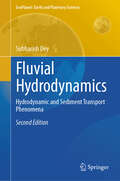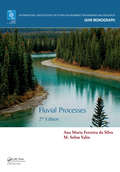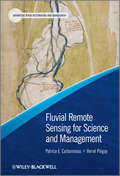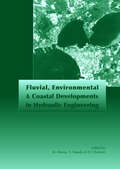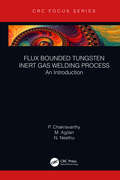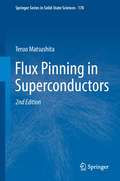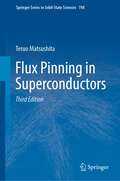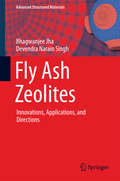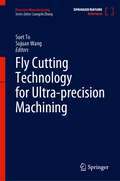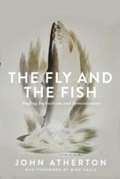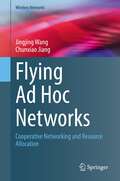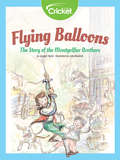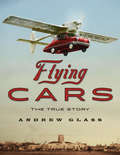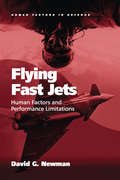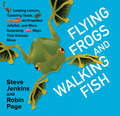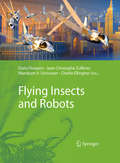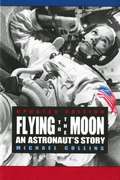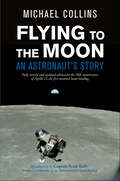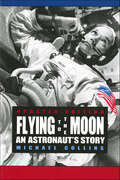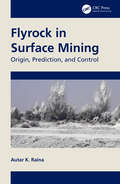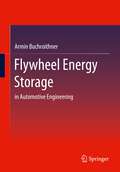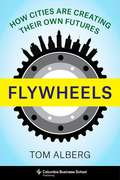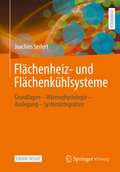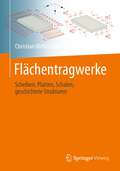- Table View
- List View
Fluvial Hydrodynamics: Hydrodynamic and Sediment Transport Phenomena (GeoPlanet: Earth and Planetary Sciences)
by Subhasish DeyThis revised second edition of the book presents an improvement of the original version in terms of recent research, corrections, and outline. The state of the art in fluvial hydrodynamics can be examined only through a careful exploration of the theoretical development and applied engineering technology. This second, updated edition focuses, since most up-to-date research findings in the field are presented, on the research aspects that involve a comprehensive knowledge of sediment dynamics in turbulent flows. It begins with the fundamentals of hydrodynamics and particle motion followed by turbulence characteristics related to sediment motion. Sediment dynamics are described from a classical perspective by applying the mean bed shear approach and additionally incorporating a statistical description for the role of turbulence. It is intended to design as a course textbook in graduate / research level and a guide for the field engineers as well, keeping up with modern technological developments. One of the most important additions is that at the end of each chapter, varieties of problems were given. Therefore, as a simple prerequisite, the background of the readers should have a basic knowledge in hydraulics in undergraduate level and an understanding of fundamentals of calculus.
Fluvial Processes: 2nd Edition (IAHR Monographs)
by Ana Maria da Silva M. Selim YalinA stream flowing in alluvium deforms its bed surface, forming ripples, dunes, bars, etc., and, in many instances, it deforms its channel entirely, thereby creating meandering or braiding patterns. It could be said that, in general, an alluvial stream and its deformable boundary undergo a variety of fluvial processes leading to the emergence of a multitude of alluvial forms. This book concerns the physics and analytical treatment of various fluvial processes and the associated alluvial bed and plan forms listed above. Following an introductory chapter on the basics of turbulent flow and sediment transport, the book covers the origin, geometric characteristics and effects of bed forms, from small- to meso-scale (ripples, dunes, alternate and multiple bars); the initiation, geometry and mechanics of meandering streams; the computation of flow, bed deformation and the planimetric evolution of meandering streams; and braiding and delta formation. The book also covers the regime concept, the time-development of a stream towards its regime state, and the formulation of stable, or equilibrium, morphology. The book distinguishes itself by its comprehensive analysis and discussion of key processes involved in large-scale river morphodynamics. The book was written primarily for researchers and graduate students of hydraulic engineering, water resources and related branches of earth sciences, but it will also prove useful for river engineers and managers.
Fluvial Remote Sensing for Science and Management
by Patrice Carbonneau Hervé PiégayThis book offers a comprehensive overview of progress in the general area of fluvial remote sensing with a specific focus on its potential contribution to river management. The book highlights a range of challenging issues by considering a range of spatial and temporal scales with perspectives from a variety of disciplines. The book starts with an overview of the technical progress leading to new management applications for a range of field contexts and spatial scales. Topics include colour imagery, multi-spectral and hyper-spectral imagery, video, photogrammetry and LiDAR. The book then discusses management applications such as targeted, network scale, planning, land-use change modelling at catchment scales, characterisation of channel reaches (riparian vegetation, geomorphic features) in both spatial and temporal dimensions, fish habitat assessment, flow measurement, monitoring river restoration and maintenance and, the appraisal of human perceptions of riverscapes.Key Features:* A specific focus on management applications in a period of increasing demands on managers to characterize river features and their evolution at different spatial scales * An integration across all scales of imagery with a clear discussion of both ground based and airborne images* Includes a wide-range of environmental problems * Coverage of cutting-edge technology * Contributions from leading researchers in the field
Fluvial, Environmental and Coastal Developments in Hydraulic Engineering: Proceedings of the International Workshop on State-of-the-Art Hydraulic Engineering, Bari, Italy, 16-19 February 2004
by Hubert Chanson Michele Mossa Youichi YasudaComprising the Proceedings of the International Workshop on State-of-the-Art Hydraulic Engineering held in Bari, Italy on 16-19 February 2004, this volume presents an in-depth investigation of the energy loss of skimming flows under a range of discharges, step and dam heights, and channel slopes. Including a wealth of information, the volume is div
Flux Bounded Tungsten Inert Gas Welding Process: An Introduction
by P Chakravarthy M Agilan N NeethuThis focus book is intended to introduce the Flux Bounded Tungsten Inert Gas Welding (FBTIG) process, which is a variant of Activated Tungsten inert gas welding process. The benefits of activating flux in the weld pool in enhancing the depth of penetration and underlying mechanisms for the same is explained in detail. The benefits of FBTIG process over other fusion welding process are highlighted. The scope for the FBTIG process to be adapted at the industrial level and the advancements in this field is detailed that enables the practicing engineers to exploit the same. Covers activated TIG process, role of activating fluxes in enhancing the depth of penetration Illustrates mechanisms associated with FBTIG process including arc constriction effect, insulation effect and reverse marangoni flow Discusses scope of FBTIG process for commercialization at the industry level Gives general overview of chronological advancements in the field of welding This book is aimed at graduate students, researchers and professionals in welding, manufacturing and engineering.
Flux Pinning in Superconductors
by Teruo MatsushitaThe book covers the flux pinning mechanisms and properties and the electromagnetic phenomena caused by the flux pinning common for metallic, high-Tc and MgB2 superconductors. The condensation energy interaction known for normal precipitates or grain boundaries and the kinetic energy interaction proposed for artificial Nb pins in Nb-Ti, etc. are introduced for the pinning mechanism. Summation theories to derive the critical current density are discussed in detail. Irreversible magnetization and AC loss caused by the flux pinning are also discussed. The loss originally stems from the ohmic dissipation of normal electrons in the normal core driven by the electric field induced by the flux motion. The readers will learn why the resultant loss is of hysteresis type in spite of such mechanism. The influence of the flux pinning on the vortex phase diagram in high Tc superconductors is discussed and the dependencies of the irreversibility field are also described on other quantities such as anisotropy of superconductor, specimen size and electric field strength. Recent developments of critical current properties in various high-Tc superconductors and MgB2 are introduced. Other topics are: singularity in the case of transport current in a parallel magnetic field such as deviation from the Josephson relation, reversible flux motion inside pinning potentials which causes deviation from the critical state model prediction, the concept of the minimization of energy dissipation in the flux pinning phenomena which gives the basis for the critical state model, etc. Significant reduction in the AC loss in AC wires with very fine filaments originates from the reversible flux motion which is dominant in the two-dimensional pinning. The concept of minimum energy dissipation explains also the behavior of flux bundle size which determines the irreversibility line under the flux creep. The new edition has been thoroughly updated, with new sections on the progress in enhancing the critical current density in high temperature superconductors by introduction of artificial pinning centers, the effect of packing density on the critical current density and irreversibility field in MgB2 and derivation of the force-balance equation from the minimization of the free energy including the pinning energy.
Flux Pinning in Superconductors (Springer Series in Solid-State Sciences #198)
by Teruo MatsushitaThis book covers the flux pinning mechanisms and properties and the electromagnetic phenomena caused by the flux pinning common for metallic, high-Tc and MgB2 superconductors. The condensation energy interaction known for normal precipitates or grain boundaries and the kinetic energy interaction proposed for artificial Nb pins in Nb-Ti, etc., are introduced for the pinning mechanism. Summation theories to derive the critical current density are discussed in detail. Irreversible magnetization and AC loss caused by the flux pinning are also discussed. The loss originally stems from the ohmic dissipation of normal electrons in the normal core driven by the electric field induced by the flux motion.The influence of the flux pinning on the vortex phase diagram in high Tc superconductors is discussed, and the dependencies of the irreversibility field are also described on other quantities such as anisotropy of superconductor, specimen size and electric field strength. Recent developments of critical current properties in various high-Tc superconductors and MgB2 are introduced.The 3rd edition has been thoroughly updated, with a new chapter on critical state model. The mechanism of irreversible properties is discussed in detail. The author provides calculations of pinning loss by the equation of motion of flux lines in the pinning potential and hysteresis loss. The readers will learn why the resultant loss is of hysteresis type in spite of such mechanism. This book aims for graduate students and researchers studying superconductivity as well as engineers working in electric utility industry.
Fly Ash Zeolites
by Bhagwanjee Jha Devendra Narain SinghThis book presents a thorough review of the state-of-knowledge and recent innovations in the synthesis of pure and improved grades of fly ash zeolites (FAZ). Addressing improvements to conventional methods, it also showcases a novel technique for the synthesis of high cation exchangers from fly ash and detailed characterization techniques for the products obtained. In addition, it examines in detail various areas of specific applications of fly ash zeolites. Over the years, several methods such as hydrothermal, fusion prior to hydrothermal, microwave assisted hydrothermal and molten salt techniques for producing FAZ have been developed. However, one-step and two-step reactions between the fly ash and alkali usually generate alkaline wastes that may cause environmental contamination. In addition, the separation of FAZ from the partially activated fly ash (the impurities) remains a major concern for researchers and industrialists alike. In view of these challenges, this book presents a novel technique for three-step activation (TSA), which focuses on recycling the fly ash-NaOH-water reaction by-products until zeolitic residue is formed. The FAZ (the final residue after third step reactions) synthesized in this manner exhibits exceptionally high cation exchange capacity, specific surface area and pore area. This book offers a comprehensive compendium of reading material on fly ash and its recycled product, the zeolites. Students at both undergraduate and graduate levels, researchers, and practicing engineers will all find this book to be a valuable guide in their respective fields.
Fly Cutting Technology for Ultra-precision Machining (Precision Manufacturing)
by Suet To Sujuan WangThis handbook covers the fly cutting technique, an ultra-precision mechanical machining technology which is regarded as the fastest and most reliable low-cost machining method to generate high quality complex surfaces. The ultra-precision raster milling provides more flexibility and suitability for freeform and structural surfaces with a uniform quality with sub-micrometric form error and nanometric surface roughness. These surfaces are widely applied into optics, medicine, biotechnology, electronics, and communications. The fundamental and latest advancing knowledge of fly-cutting technology is important for the future development and applications in ultra-precision mechanical machining technology. This book provides a good reference for fly-cutting technology in ultra-precision machining for undergraduate and postgraduate students, researchers, engineers, and postdoctoral fellow in advanced manufacturing area. It gives the audience an overview of the working principles, process mechanism, salient features, applications, and research directions of ultra-precision fly-cutting technology.
Fly and the Fish: Angling Instructions and Reminiscences
by John Atherton Mike VallaThe classic book from a revered artist and fly-tying master. An internationally renowned artist, John Atherton (1900-1952) was also a legend in the world of fly fishing. This lost classic, originally published in 1961, combines his evocative memoirs of Vermont fishing expeditions with practical directions for fly-tying. Atherton’s reminiscences and instructions are complemented by his exquisite sketches of tools and scenes from the angler’s life. The author’s wife, artist Maxine Atherton, notes in her introduction that in addition to his skills as an accomplished artist and fine sportsman John Atherton was a romantic realist, whose exuberant outbursts of wonder over natural phenomena celebrated our planet’s everyday magic. Indeed, Atherton’s work was featured in the Museum of Modern Art’s 1943 exhibition of American Realists and Magic Realists. On a more practical note, Maxine Atherton adds that the Impressionistic fly patterns such as those featured in this book have worked wonders for her fishing, fooling trout in rivers throughout North America and Europe.
Flying Ad Hoc Networks: Cooperative Networking and Resource Allocation (Wireless Networks)
by Chunxiao Jiang Jingjing WangRelying on unmanned autonomous flight control programs, unmanned aerial vehicles (UAVs) equipped with radio communication devices have been actively developed around the world. Given their low cost, flexible maneuvering and unmanned operation, UAVs have been widely used in both civilian operations and military missions, including environmental monitoring, emergency communications, express distribution, even military surveillance and attacks, for example. Given that a range of standards and protocols used in terrestrial wireless networks are not applicable to UAV networks, and that some practical constraints such as battery power and no-fly zone hinder the maneuverability capability of a single UAV, we need to explore advanced communication and networking theories and methods for the sake of supporting future ultra-reliable and low-latency applications. Typically, the full potential of UAV network’s functionalities can be tapped with the aid of the cooperation of multiple drones relying on their ad hoc networking, in-network communications and coordinated control. Furthermore, some swarm intelligence models and algorithms conceived for dynamic negotiation, path programming, formation flight and task assignment of multiple cooperative drones are also beneficial in terms of extending UAV’s functionalities and coverage, as well as of increasing their efficiency. We call the networking and cooperation of multiple drones as the terminology ‘flying ad hoc network (FANET)’, and there indeed are numerous new challenges to be overcome before the idespread of so-called heterogeneous FANETs. In this book, we examine a range of technical issues in FANETs, from physical-layer channel modeling to MAC-layer resource allocation, while also introducing readers to UAV aided mobile edge computing techniques.
Flying Balloons: The Story of the Montgolfier Brothers
by Joseph TaylorDid you know hot air balloons were dreamed up by a French boy in the 1700s? Joseph Montgolfier devoted his life to experiments that he hoped would allow him to fly. With the help of his little brother, his invention allowed humans to fly for the first time in history!
Flying Cars: The True Story
by Andrew GlassStories of inventors who have aimed for the sky: &“Start your engines and get ready to take off for an amazing read&” (Kirkus Reviews, starred review). Humans have always wanted to fly—and as soon as there were planes and cars, many people saw a combination of the two as the next step for personal transportation. Visionary engineers and inventors did their best to make the flying car a reality, not just an elusive dream. This book is a breezy account of hybrid vehicles and their creators, and of the intense drive that kept bringing inventors back to the drawing board despite repeated failures and the dictates of common sense. Illustrated with archival photos, this entertaining survey tells the stories of dreamers from Robert Fulton to Henry Ford to Buckminster Fuller, taking readers as far back as Icarus and forward into the present day—with a look toward the possibilities of the future as well. &“Readers learn about many intriguing airplane-car hybrids, such as the Airphibian, invented by Robert Fulton, who flew his vehicle at 110 miles per hour, landed it, single-handedly converted it into a car in under five minutes, then &‘drove the convertible proudly into Manhattan at a breezy 55 miles per hour.&’ These stories of invention are undeniably appealing. . . . Fascinating.&” —School Library Journal Includes illustrations, source notes, bibliography, and an index
Flying Fast Jets: Human Factors and Performance Limitations (Human Factors in Defence)
by David G. NewmanThis book provides a detailed general overview of the human factors and performance limitations associated with flying fast jets, integrating all the latest available research literature on the demanding operational tasks faced by such pilots and aircrews. As such, it has a strong military focus, dealing with pilots of fighter aircraft, attack aircraft and lead-in fighter trainer aircraft that are traditionally only single or dual pilot operations. The book deals not only with the issue of G force, but discusses ejection and escape/survival, disorientation, high altitude physiology, pilot training and selection, helmet-mounted equipment, situational awareness, data fusion and multi-sensor integration, human machine interface issues and advanced cockpit design. It examines the human performance issues associated with the technological advances made in fast jets, such as increased manoeuvrability, increased use of the pilot’s head as a mounting platform for sensor and weapons systems, and the complexities involved in the human-machine interface within these aircraft.
Flying Fortress: The Illustrated Biography of the B-17s and the Men Who Flew Them
by Edward JablonskiRenowned throughout the world for its strength and destructiveness, the Flying Fortress was one of the greatest fighting airplanes of all time. In this comprehensively documented biography, Edward Jablonski tells the story of the Flying Fortress Boeing B-17, America’s legendary long-range bomber. From the B-17's near death in infancy to the emergence of its successor, the Superfortress, Flying Fortress captures the exhilarating career of the B-17 with thrilling accounts of the exploits of these planes and their pilots. In this unforgettable history, Jablonski details the Fortress’s role in the strategic and tactical issues of air war, and chronicles the B-17’s roles in famous raids including Regensburg, Marienburg, Munster, Schweinfurt, Dresden, and Berlin, along with its part in great battles, such as D-Day. Masterfully written, Flying Fortress is a classic in aviation literature with over 400 illustrations (many unpublished action photos) in addition to a section on the design of the Flying Fortress, which includes a number of detailed cutaway drawings. Approximately 60 pages from the Flying Fortress’s Piloting Manual are also featured herein. Find out why the Flying Fortress ultimately redefined the concept of war.
Flying Frogs and Walking Fish: Leaping Lemurs, Tumbling Toads, Jet-Propelled Jellyfish, and More Surprising Ways That Animals Move
by Steve Jenkins Robin PageA red-lipped batfish waddles across the sea floor on its fins, searching for small sea creatures to eat. Other animals may fly or glide, or jet-propel themselves to get around. These creatures come equipped with legs, wings, or tentacles, and they often move from place to place in surprising ways. In the latest eye-catching escape into the kingdom of Animalia, Caldecott Honor-winning team Jenkins and Page show how animals roll, fly, walk, leap, climb, swim and even flip! This fascinating and fun illustrated nonfiction melds science, art, biology, and the environment together in a detailed and well-researched book about how animals move in our world today.
Flying Insects and Robots
by Dario Floreano Jean-Christophe Zufferey Mandyam V. Srinivasan Charlie EllingtonFlying insects are intelligent micromachines capable of exquisite maneuvers in unpredictable environments. Understanding these systems advances our knowledge of flight control, sensor suites, and unsteady aerodynamics, which is of crucial interest to engineers developing intelligent flying robots or micro air vehicles (MAVs). The insights we gain when synthesizing bioinspired systems can in turn benefit the fields of neurophysiology, ethology and zoology by providing real-life tests of the proposed models. This book was written by biologists and engineers leading the research in this crossdisciplinary field. It examines all aspects of the mechanics, technology and intelligence of insects and insectoids. After introductory-level overviews of flight control in insects, dedicated chapters focus on the development of autonomous flying systems using biological principles to sense their surroundings and autonomously navigate. A significant part of the book is dedicated to the mechanics and control of flapping wings both in insects and artificial systems. Finally hybrid locomotion, energy harvesting and manufacturing of small flying robots are covered. A particular feature of the book is the depth on realization topics such as control engineering, electronics, mechanics, optics, robotics and manufacturing. This book will be of interest to academic and industrial researchers engaged with theory and engineering in the domains of aerial robotics, artificial intelligence, and entomology.
Flying to the Moon: An Astronaut's Story
by Michael CollinsIn this entrancing account, space traveler Michael Collins recalls his early days as an Air Force test pilot, his astronaut training at NASA, and his unparalleled experiences in orbit, including the Apollo 11 mission, the first manned lunar landing. The final chapter to his autobiography, revised and updated for this edition, is an exciting and convincing argument in favor of mankind's continued exploration of our universe.
Flying to the Moon: An Astronaut's Story
by Michael CollinsBased on the adult bestseller Carrying the FireIn time for the 50th anniversary of man's first landing on the moon, this re-release of Michael Collins's autobiography is a bold, sparkling testament to exploration and perseverance. In this captivating account, space traveler Collins recalls his early days as an Air Force test pilot, his training at NASA, and his unparalleled experiences in orbit, including the Apollo 11 mission, the first manned lunar landing. The final chapter to this autobiography is an exciting and convincing argument in favor of mankind's continued exploration of our universe. Originally published in 1976 and updated for this new edition, including an introduction from astronaut Scott Kelly, Collins's voice and message are sure to resonate with a new generation of readers.
Flying to the Moon: An Astronaut's Story
by Michael CollinsIn this entrancing account, space traveler Michael Collins recalls his early days as an Air Force test pilot, his astronaut training at NASA, and his unparalleled experiences in orbit, including the Apollo 11 mission, the first manned lunar landing. The final chapter to his autobiography, revised and updated for this edition of Flying to the Moon, is an exciting and convincing argument in favor of mankind's continued exploration of our universe. "Several astronauts have written about their experiences, but none so well as Michael Collins...This is just the book to give the child whose parents made Yeager and The Right Stuff best sellers."-The Washington Post Book World
Flyrock in Surface Mining: Origin, Prediction, and Control
by Autar K. RainaThis book provides a comprehensive understanding of historical and recent research, with a critical review of several aspects of the flyrock phenomenon, along with classification of pertinent literature. This puts flyrock into proper perspective and develops a comprehensive regime for flyrock prediction and control. It also addresses the blast danger zone demarcation based on scientific understanding in comparison to the consequence-based approach supported by pertinent case studies. Features: Discusses exclusive material on flyrock in surface mining. Presents comprehensive and critical review of the flyrock phenomenon. Reviews prediction and control mechanisms in vogue with scientific and risk-based definitions of blast danger zone. Provides new insights into the flyrock definitions, prediction, and prevention along with the research approach to the problem. Includes Indian case studies and summarize global data available in the published domain. This book is aimed at researchers and graduate students in mining and civil engineering, engineering geology, and blasting.
Flywheel Energy Storage: in Automotive Engineering
by Armin BuchroithnerStoring energy is one of the most important challenges of our time. Energy storage systems are not only essential for switching to renewable energy sources, but also for all mobile applications. Electro-mechanical flywheel energy storage systems (FESS) can be used in hybrid vehicles as an alternative to chemical batteries or capacitors and have enormous development potential. In the first part of the book, the Supersystem Analysis, FESS is placed in a global context using a holistic approach. External influences such as the vehicle, driver and operating strategy, including socio-psychological aspects, are analyzed with regard to their interaction with the memory. From this, optimal application scenarios are derived and the development goals relevant for market success are defined. In the second part, the consideration of the subsystem, those critical components in the FESS are identified which are responsible for the achievement of the technical target properties. From the point of view of maximum cost reduction, specific solutions for the design of the key components are presented and their suitability is validated through empirical studies on the housing, bearing and rotor as well as through overall prototypes.This book is a translation of the original German 1st edition Schwungradspeicher in der Fahrzeugtechnik by Armin Buchroithner published by Springer Fachmedien Wiesbaden GmbH, part of Springer Nature in 2019.
Flywheels: How Cities Are Creating Their Own Futures
by Tom AlbergOnce a blue-collar outpost, Seattle, home to Microsoft, Amazon, and hundreds of startups, transformed into one of the world’s major innovation hubs in less than twenty years. As other cities try to solve the riddle of creating vibrant economies, many have looked to Seattle as a model for tech-driven urban renaissance. However, that success comes with skyrocketing housing costs, increasing homelessness, public safety concerns, persistent racial inequality, and a widening gap between the haves and have-nots. Against that backdrop, big tech has become a popular target.Tom Alberg, a venture capitalist who was one of the first investors in Amazon, draws on his experience in Seattle’s tech boom to offer a vision for how cities and businesses can build a brighter future together. He explores ways that cities can soar to prosperity by creating the conditions that encourage innovation. Like flywheels, livable cities generate momentum by drawing creative citizens who launch businesses. Success attracts more talent, energizing local economies and accelerating further innovation. Alberg emphasizes the importance of city governments and tech companies partnering to address civic challenges. He reflects on why the benefits of the tech boom have not been distributed equally and what business and government leaders must do differently to ensure inclusive growth. The book also examines success stories from smaller cities and their lessons for other up-and-coming tech hubs. Demonstrating the need for innovative thinking that encourages livability alongside economic growth, Flywheels is timely reading for everyone from mayors to business leaders to engaged citizens.
Flächenheiz- und Flächenkühlsysteme: Grundlagen – Wärmephysiologie – Auslegung – Systemintegration
by Joachim SeifertDieses Buch beschreibt die grundlegenden Konstruktionen von Flächenheiz- und Flächenkühlsystemen aus theoretischer Sicht. Die Wirkung der Systeme wird in Hinblick auf die thermische Behaglichkeit beschrieben. Zusätzlich erfolgt eine detaillierte Betrachtung der Systemintegration.
Flächentragwerke: Scheiben, Platten, Schalen, geschichtete Strukturen
by Christian MittelstedtDieses Buch bietet eine umfassende Darstellung der Statik der Flächentragwerke und ist in fünf Abschnitte unterteilt. Nachdem im ersten Abschnitt die Grundlagen der Elastizitätstheorie und der Energiemethoden der Elastostatik kurz eingeführt wurden, widmet sich der zweite Abschnitt der Statik der Scheibentragwerke. Neben isotropen Scheiben in kartesischen und polaren Koordinaten werden außerdem Näherungsverfahren sowie anisotrope Scheiben behandelt. Der nachfolgende dritte Abschnitt behandelt Plattenstrukturen, wobei auch hier Platten in kartesischen und polaren Koordinaten behandelt werden und zudem Näherungsverfahren sowie Plattentheorien höherer Ordnung besprochen werden. Weitere Kapitel dieses Abschnitts behandeln das Plattenbeulen sowie die geometrisch nichtlineare Analyse. Der vierte Abschnitt dieses Buchs ist der Statik geschichteter Flächentragwerke gewidmet. Hierbei werden sowohl die Klassische Laminattheorie als auch Laminattheorien höherer Ordnung diskutiert, und als ein Spezialfall wird die sog. Sandwichbauweise angesprochen. Der fünfte und letzte Abschnitt dieses Buchs ist den Schalen, also gekrümmten Flächentragwerken gewidmet, wobei hier der gängigen Einteilung in die Membrantheorie einerseits und der Biegetheorie andererseits gefolgt wird.Dieses Buch richtet sich an Studierende an Fachhochschulen und Universitäten, aber auch an Ingenieurinnen und Ingenieure in der Praxis sowie an Forscherinnen und Forscher der Ingenieurwissenschaften.
